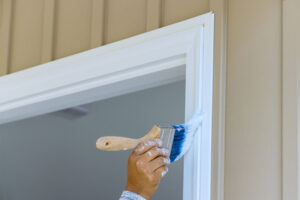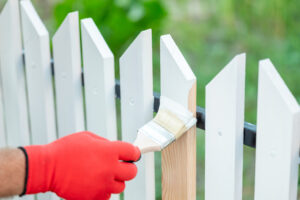
Best Paint for Trim and Baseboards
Baseboards and trim can elevate the appearance of your home’s interior, but even the most ornate trim piece will look dilapidated if it is not
Exterior house painting costs are determined by factors such as the number of stories, size and type of material. Painting the exterior of a house is usually done over several days unless you have a large crew working. According to This Old House, the average cost to paint a 2,000 sq. ft. house ranges starts at around $5,200
A house with three stories, such as a townhouse, will cost even more since the greater square footage inside equates to more exterior space that needs preparation and painting.

Painting cost is divided between the cost of the paint and materials and the labor time. Exterior paint can be purchased in five-gallon buckets for some cost savings, and materials like sprayers, rollers, trim brushes, a tall ladder, plastic for covering windows and a power washer, also become part of the total.
The other cost is labor, and an exterior house painting requires proper preparation to make sure the paint adheres well. Painting a house shouldn’t be done in a rush or without preparing the surface of the house correctly. Ideally, the weather should be sunny with moderate temperatures with very little wind.
Several different situations may require you to paint your exterior.

Make sure to purchase enough paint. And for exteriors, you want a paint rated for exterior use. That will ensure it’s resistant to fading, sun damage and water exposure. It’s best to buy the paint all at once so it’s mixed at the same time. Going back for a gallon at a time can give you slightly different results, even with a calibrated machine.
A good exterior paint has a matte finish because any shine can result in an artificial or plastic-like appearance once the sun hits it.
When choosing your paint, first determine if you want to retain the same color you have or go with something totally different. If staying with the same color, bring a sample in and look for colors one shade lighter and darker than your current paint color. Going a shade lighter can make the home look totally refreshed, and it will darken with time.
If you are planning on completely changing your exterior paint color, consider the other colors around your home and bring photos of your home to the paint store. What color is your roof? Your door? Even landscaping can look drastically different depending on the paint color behind it.
If you are painting brick, know that porous material absorbs paint differently than wood or siding, so test a few spots. And take a moment to think about where the light hits your house. The bright white you pick for your exterior may wind up being blinding if you don’t consider the sunlight.
First, the house exterior is power washed to remove dust, debris, cobwebs, and old chipped paint in severe cases. Any remaining dirt clinging to the exterior can cause the paint to dry unevenly or look gritty. The house should be allowed to dry fully before new paint is applied, so typically this is done the day before painting.

Second, prior to painting, any damaged siding is replaced or repaired. This can include replacing boards, rotted or damaged soffits and re-nailing any loose boards.
Next, old wires from unused internet cables or electrical boxes can be removed or cut, nail holes filled, and boards and gaps caulked. Once this is done, it’s time to protect the windows from any paint overspray. Plastic coverings should be taped carefully over the windows and secured on all sides to prevent them from coming off with the wind.
Now it’s finally time to paint! Exterior painting is done most efficiently with a paint sprayer, but if you’re painting brick, a roll-on application is sometimes preferred to properly adhere to porous brick.
Painting the soffits, cutting in around windows and handling fine trim work can be done by hand first, leaving the largest part of the square footage to be handled by the paint sprayer. A paint sprayer makes for even application and quickly handles large surface areas, requiring only minimal touchups. This also cuts down on labor costs by reducing the amount of exterior walls needing to be painted by hand.
The preparation prior to painting is key to ensuring the longevity of the house paint. In fact, some exterior paint can last up to 25 years depending on the kinds of weather you receive. If your painters did the necessary prep work and you purchased high-quality exterior paint, then occasional touch-ups may be all you need to worry about.
If you’re feeling ambitious, you may use a soft broom annually to sweep off any dust or dirt from your exterior. Be careful of using a power washer as too high a setting can remove paint.
Exterior painting costs scale depending on the size of the home, but the results are worth it. A fresh coat of paint can protect your home, improve its appearance and ability to withstand weather and give it a personal touch that is uniquely your own.

Baseboards and trim can elevate the appearance of your home’s interior, but even the most ornate trim piece will look dilapidated if it is not

You’ve just installed your beautiful new fence! Now, while it cures, you have the difficult decision of choosing a stain or paint color. With all

How to Find the Right Color for Your Interior Paint Job Have you procrastinated painting the walls in your home because you’re worried you won’t

Baseboards and trim can elevate the appearance of your home’s interior, but even the most ornate trim piece will look dilapidated if it is not

You’ve just installed your beautiful new fence! Now, while it cures, you have the difficult decision of choosing a stain or paint color. With all